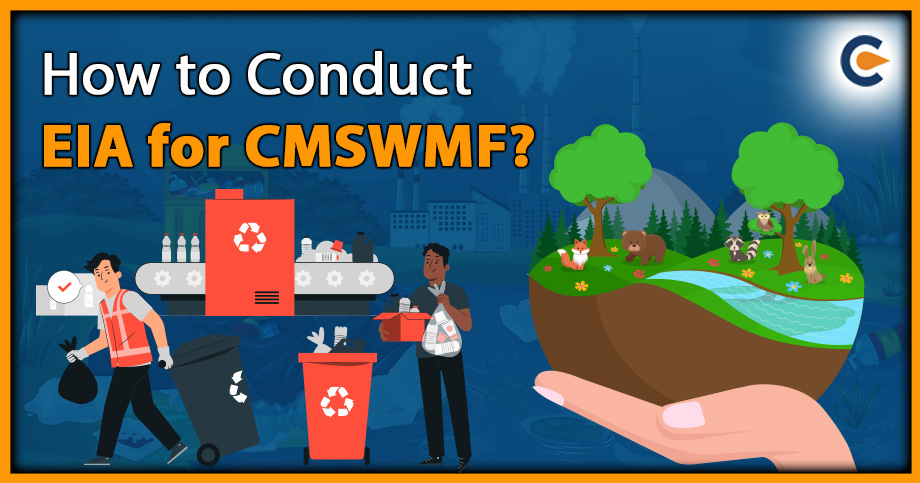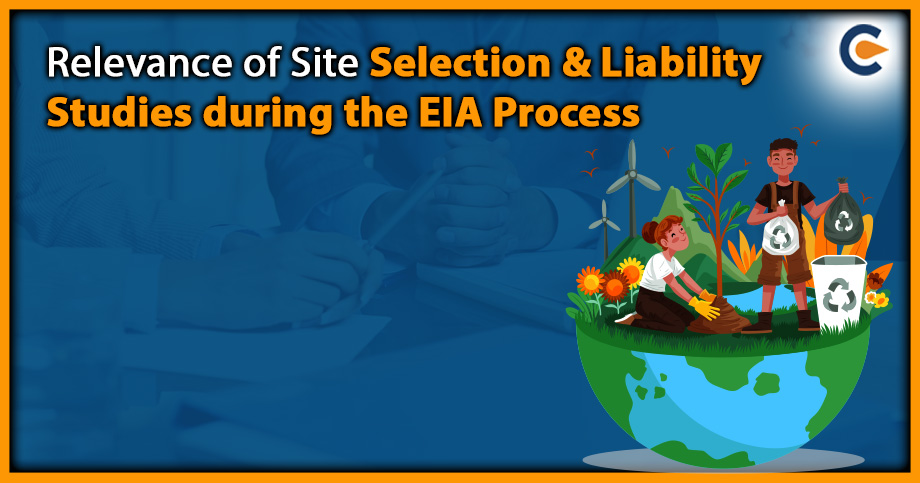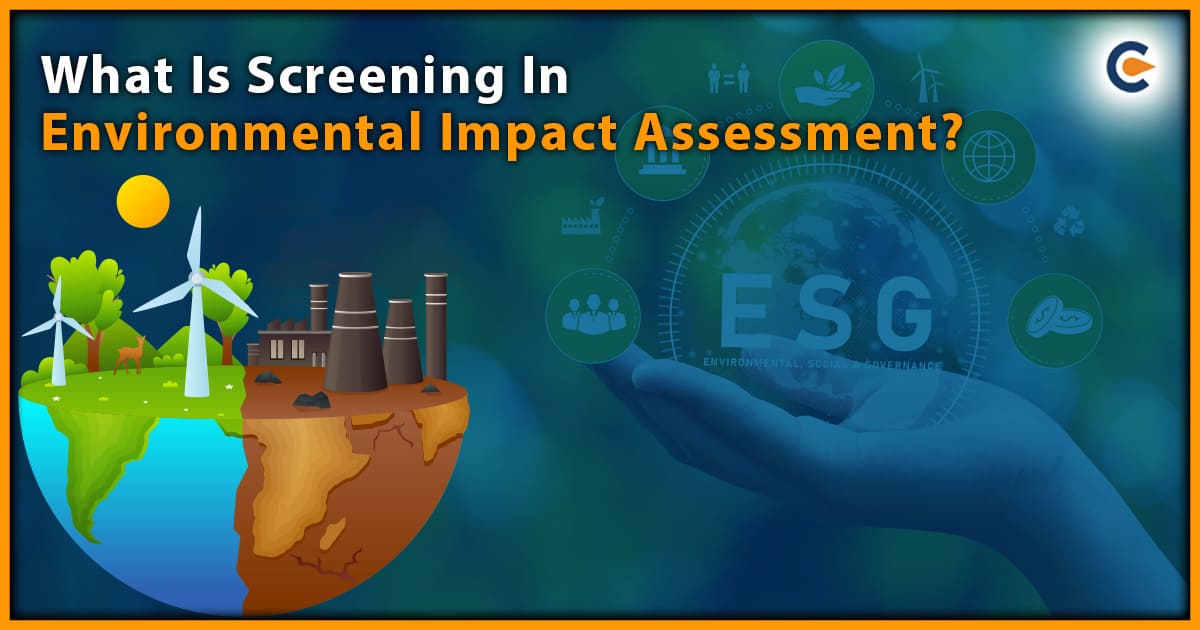Environmental Impact Assessment (EIA) for Common Municipal Solid Waste Management Facility (CMSWMF) is a process of identifying, predicting, evaluating and mitigating the social, biophysical, and other relevant impacts of the developmental proposal prior to a major decision being taken and a commitment made. The study of EIA for CMSWMF integrates the environmental concerns of various activities into the processes of decision-making.
The Project/activity is covered under category B of item 7 (i) Common Municipal Solid Waste Management Facility (CMSWMF)’ of the Schedule to the EIA Notification, 2006 and its amendments, and requires appraisal (EC) at State Level (SEIAA). However, due to the absence of SEIAA/SEAC, the proposal has been appraised at the Central level by sectoral EAC.
The following is the categorisation for project that requires EIA for Common Municipal Solid Waste Management Facility for obtaining prior Environmental Clearance:
- Category ‘B’ projects: Requires an EIA for CMSWMF (In case of Landfill disposal site)
Note: In case of General conditions, the project will be treated as Category “A”.
Applicability of EC for CMSWMF
As per EIA Notification 2006 and its subsequent OM and circular dated 7.11.2017 Expert group revisited the process of obtaining prior EC regarding:
- Applicability of EC: Proposing a new Landfill Disposal Site
- Non-Applicability of EC: Door-to-door collection, segregation, composting, refused derived fuel (RDF)
Locating a landfill site or municipal solid waste (MSW) disposal site is a contentious issue, and there is a tendency to locate them far from the habitation but near forests, rivers, ponds, wetlands and low-lying areas that are critical from environmental points, of view, it may not be appropriate to exempt this activity of MSW disposal site or landfill site from the requirement of prior EC.


Figure 1.1: Waste Management Hierarchy
The Objective of Conducting EIA for CMSWMF
- The major purpose of this report is to prepare an environmental statement on the assessment of the likely environmental impacts of the proposed Integrated Municipal Solid Waste Management Facility.
- Management of solid waste is of growing concern to the general public at large, local authorities and business communities in cities and towns across India. In order to comply with Municipal Solid Waste (Management and Handling) Rules, 2016, proper collection, segregation, recycling and disposal are much needed.
- Conducting an EIA for Common Municipal Solid Waste Management Facility develop mitigation measures so as to minimize pollution, environmental disturbance and nuisance during the operation period of the proposed project.
Clearance and NOCs Required For Conducting EIA for CMSWMF
- Forest Clearance
- Wildlife Clearance (NBWL)
- CRZ Clearance (Coastal Regulation Zone) as per issued notification 2011
- Central Ground Water Authority (CGWA) NOC
- Forest Certificate
- Site-specific conservation plan & Wildlife Management Plan (in case of the presence of schedule-I species in the study area) approved by the chief wildlife warden.
Applicable Laws & Legislations
- Municipal Solid Waste (M&H) Rules, 2016
- Plastic waste management Rules 2016 amended in 2022
- The Hazardous Waste (M&H) Rules, 1989
- Hazardous Waste (Management, Handling & Transboundary Movement) Rules 2008
- Environment (Protection) Act, 1986
- EIA Notification, 2006
- Air (P&CP) Act, 1981
- Water (P&CP) Act, 1974
- Forest (Conservation) Act, 1988
- Wildlife (Conservation) Act, 1972
How to Carry Out EIA for CMSWMF
Submission of EIA for Common Municipal Solid Waste Management Facility on the basis of approved ToR letter issued by SEAC/SEIAA further requires prior EC as per EIA Notification.
Stages Involved In the EIA Process
- Screening- This stage aware the project proponent of their obligations before deciding on the budget, project design and execution plan. Also, decides if an EIA is required or not.
- Scoping – To identify the environmental impacts of the project and defines the scope of study in the EIA report.
- Term of Reference (ToR)– After the scoping stage, the project proponent/consultant applies at the state level (SEIAA/SEAC). It consists of the scope of the project and the timeline for carrying out an EIA.
- Draft Environmental Impact Assessment Report – The draft report of an EIA includes all the baseline details of the project, its impacts and the development of mitigation measures accordingly.
- Public Consultation – This stage plays a major role in the entire stage of the EIA for CMSWMF. A public hearing conducts at the project site, and the proposal is presented in front of the public for their opinion and views on the existing or proposed project.
- Final EIA – Final EIA for CMSWMF is prepared after the incorporation of PH minutes by the Pollution control board and submitted to the central or state level for review.
- Appraisal – It decides whether the Environmental Impact Assessment is satisfactory or not. On that basis, the concerned authority grants the EC or rejects it accordingly.
Submission Process of Final EIA for Common Municipal Solid Waste Management Facility
- Identification of the site and a preliminary site visit by the project proponent and consultant for the preparation of a checklist.
- Registration on the Parivesh portal by the Environment consultant.
- Drafting and submission of forms (Form 1, PFR) for the ToR after registration
- Drafting of presentation for ToR
- Agenda/Meeting for ToR
- Grant of ToR by Appraisal Committee (SEIAA) and subsequently baseline data generation by NABL-approved Lab
- Submission of Draft EIA report for conduction of public hearing to SPCB
- Presentation and Conduct of Public hearing
- Submission of final EIA report to SEAC for the grant of EC after incorporation of Public Hearing minutes in the EIA report and submission on the Parivesh portal[1]
- Drafting of final EC presentation
- Agenda/Meeting for final EC
- Grant of EC by the appraisal committee
Generic Structure of EIA for CMSWMF
| Chapter No. | EIA Structure | Contents |
| 1. | Introduction | Presents an introduction along with the scope and objective of this EIA study. |
| 2. | Project Description | Presents brief project technical details. |
| 3. | Description of the Environment | Baseline status for various environmental parameters in the study area. |
| 4. | Anticipated Environmental Impacts and mitigation measures | Identification, prediction, and evaluation of environmental impacts due to the proposed project activities. Also presents proposed mitigation measures. |
| 5. | Analysis of Alternatives (Technology & site) | Describes alternative sites and technologies considered for this project. |
| 6. | Environmental Monitoring Program | Details of monitoring, audit and reporting. |
| 7. | Additional Studies | Describes details of public consultation, Risk Assessment and Disaster Management Plan, Social Impact assessment, |
| 8. | Project benefits | Improvement in physical infrastructureImprovement in social infrastructureEmployment potential – skilled, semi-skilled and unskilledOther tangible benefits |
| 9. | Environmental Cost benefits | If recommended at the Scoping stage |
| 10. | Environment Management Plan (EMP) | Description of the administrative aspects to ensure whether mitigative measures are implemented or not, and their effectiveness monitored after the approval of EIA |
| 11. | Summary & Conclusion (Summary of EIA report) | Describes the overall justification of the project and how adverse impacts will be mitigated. |
| 12. | Disclosure of Consultants engaged | Company Profile with resumes of team members |
Annexures required for preparation of EIA for CMSWMF
- ToR Letter
- Site layout and Landfill Design Plan
- Land documents with Khasra Map
- Baseline Monitoring Data
- Public Hearing Proceedings
- Detailed Project Report
- DCF certificate
Composition of Team of Experts
- NABET Consultant (EIA Co-ordinator, Team members, FAE, FAA)
- NABL Approved Lab
- Civil Engineer
- Air and noise quality specialist
- Occupational health
- Geology/geo-hydrology
- Ecologist
- Transportation Specialist
- Safety and health specialist
- Sociologist, etc.
Conclusion
Carrying out an EIA for CMSWMF is very important to identify the risk associated with the projects and reduce and minimize the impacts on the environment and the human population. Land disposal of solid wastes has been practiced for centuries. In view of the growing challenge of solid waste management carrying out the Environmental Impact Assessment is necessary through the help of an accredited NABET Consultant to prepare a quality report and to obtain prior Environmental Clearance.
Also Read:
Types Of Environmental Impact Assessment











